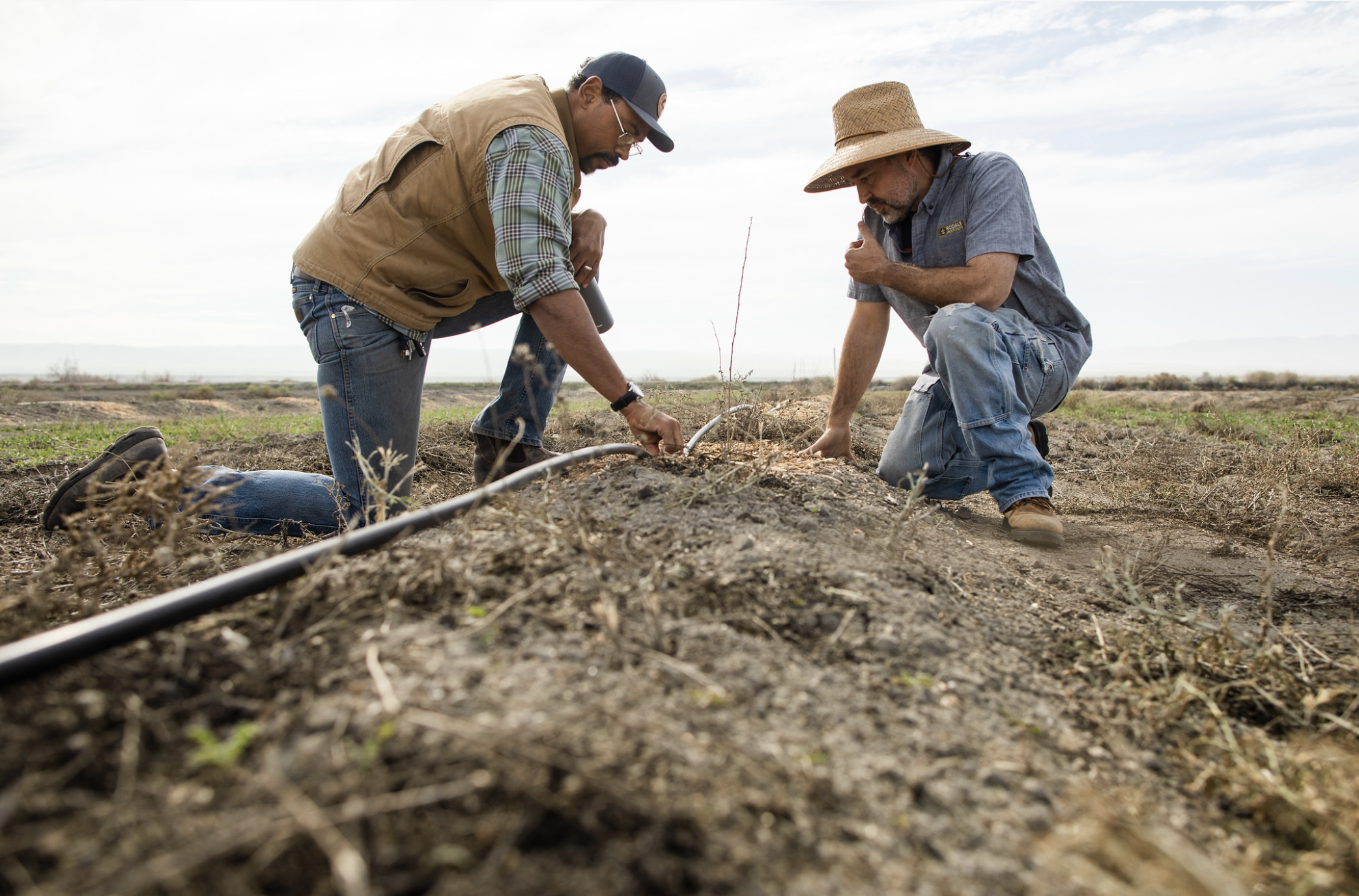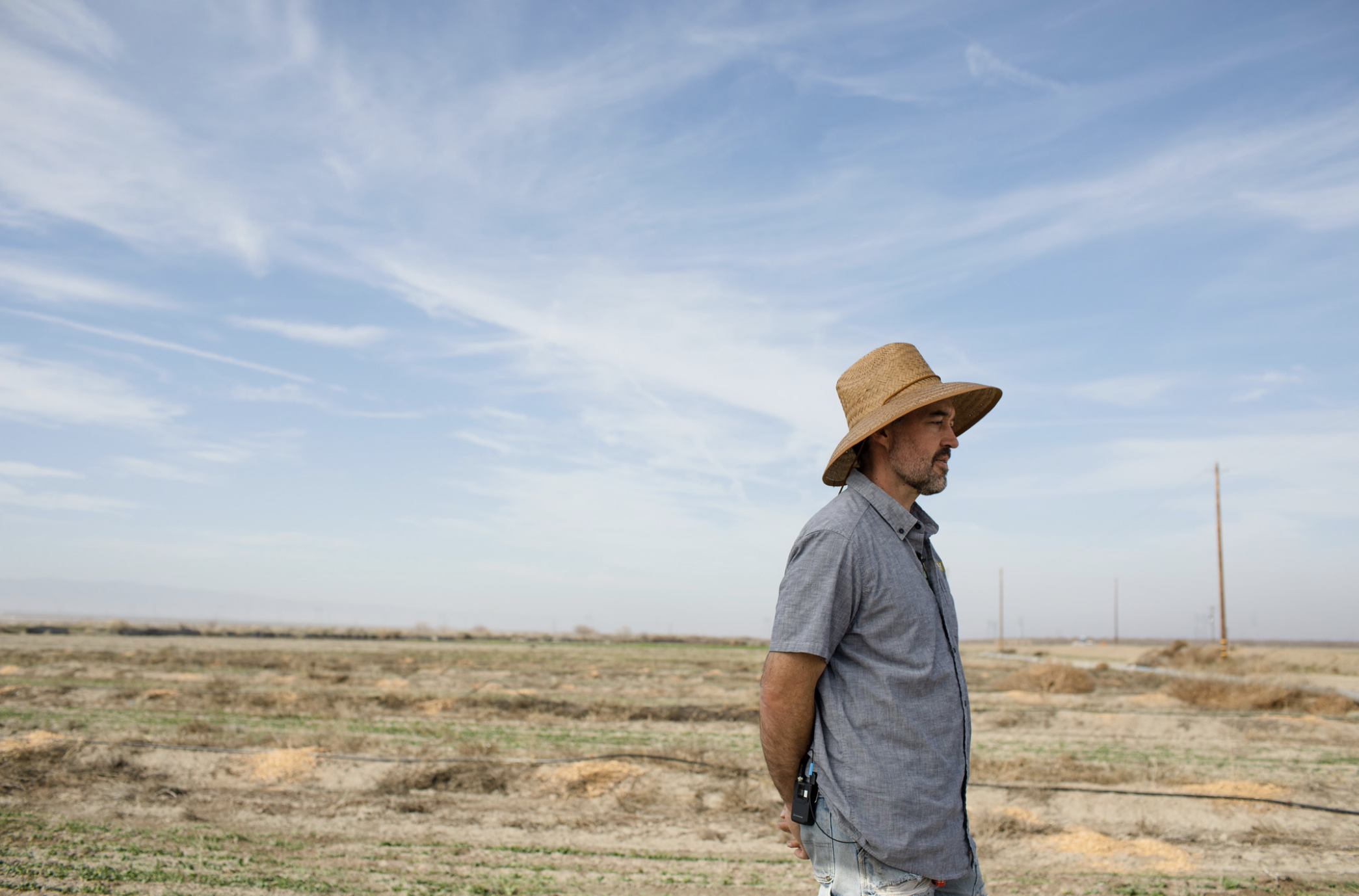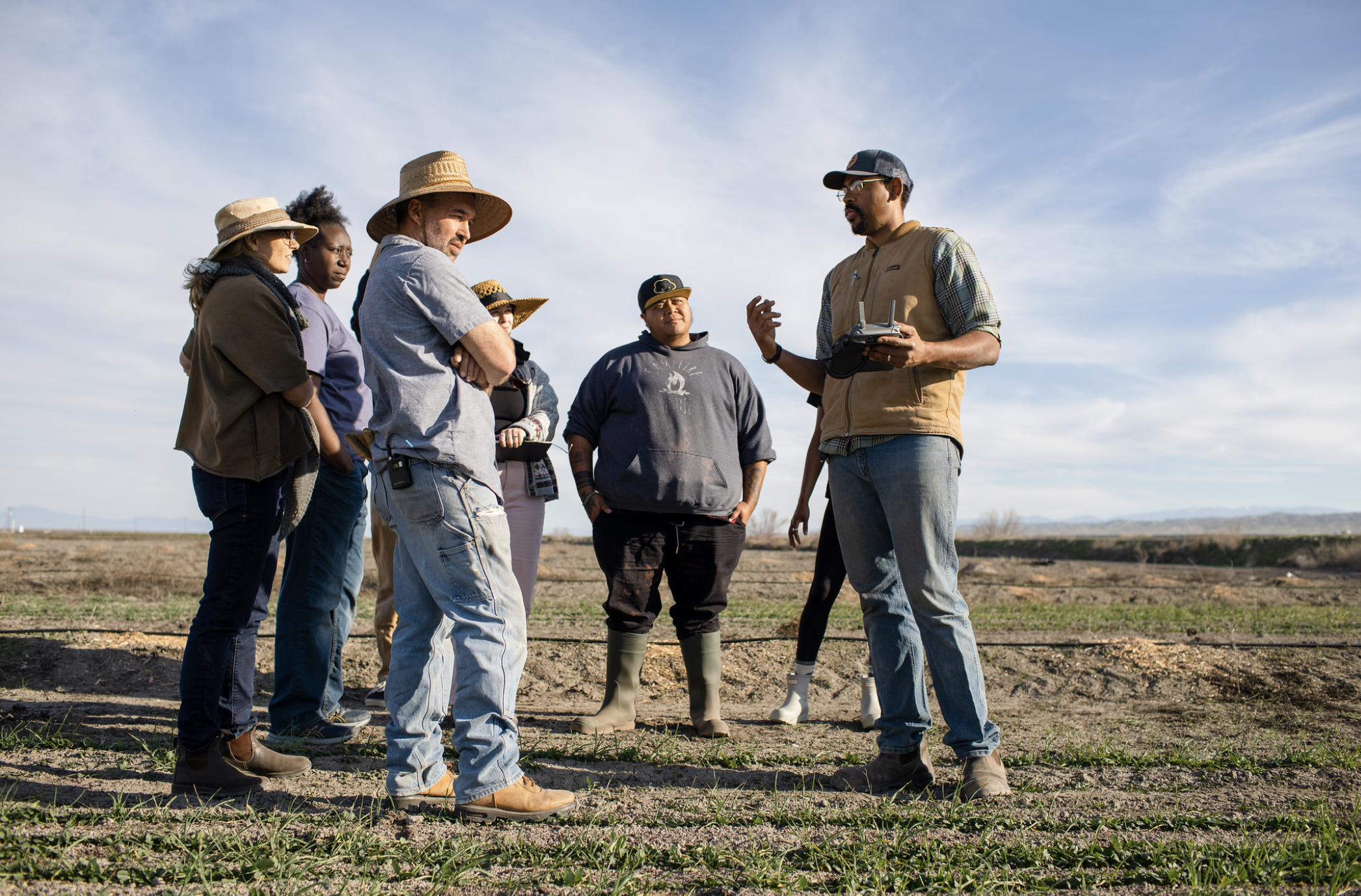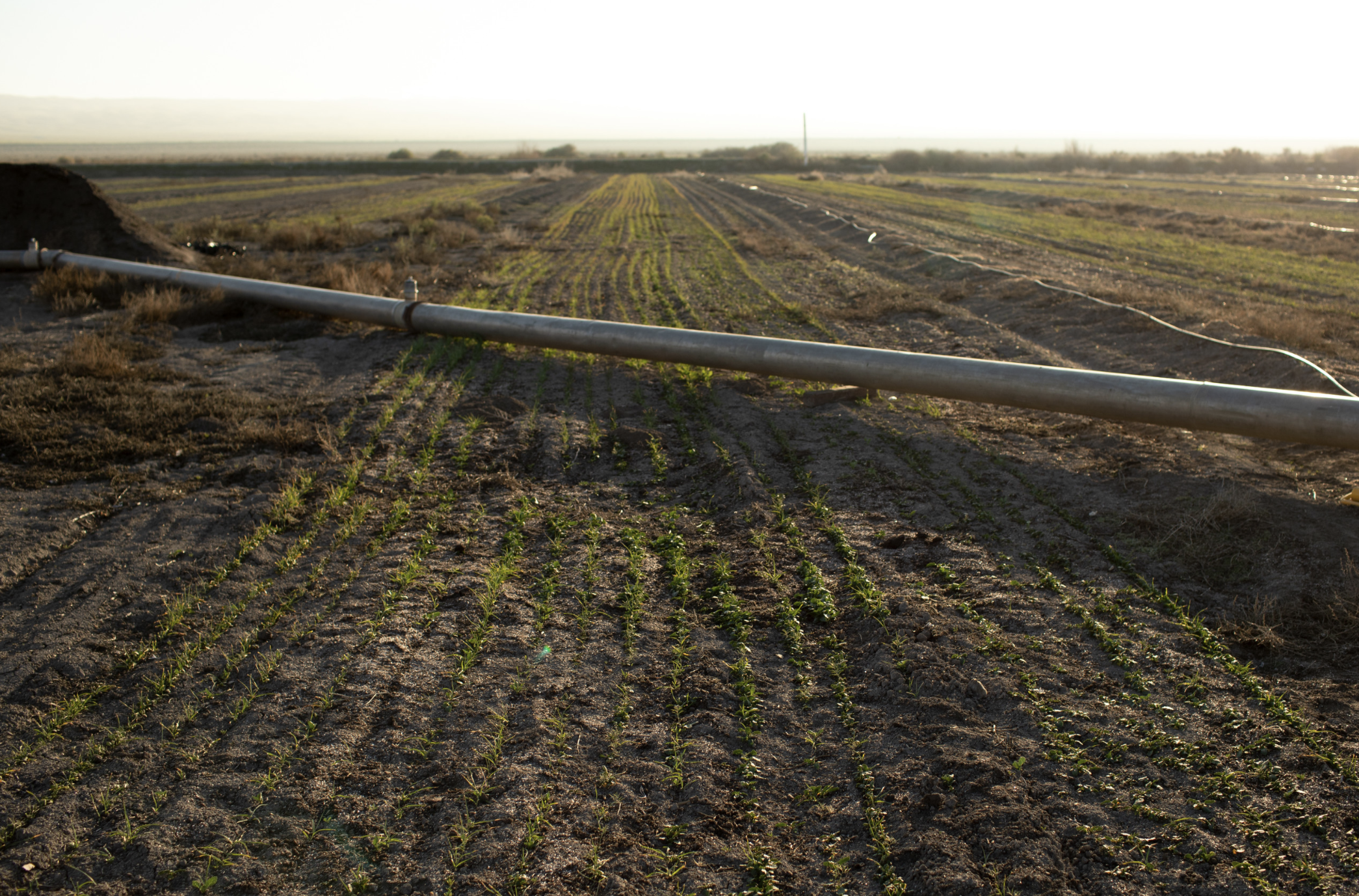
By Sierra Downey
Photography by Paige Green
What will the San Joaquin Valley–home to one-quarter of the nation’s food production–look like fifty years from now? Fifth-generation farmer Nathanael Gonzales-Siemens and a team of farming and fiber systems advocates are undertaking an experiment in Buttonwillow, CA that may determine part of the answer.
Nearly 30 miles west of Bakersfield, at an ancestral trading crossroads of the Yokuts, Chumash, and Gabrielino peoples, lies the modest 10-acre demonstration site. It sits in what Gonzales-Siemens calls “the liminal zone.” Backed up to the California Aqueduct and foothills, the site faces acres upon acres of the keystone crop that once gave the region its sobriquet: “Cotton Capital of California.” On a late January morning, with temperatures hanging in the low thirties, small green shoots carpet the soil in between berms of dirt. The mounds are spaced widely apart and crowned with intermittent seedlings. Like his grandfather and great-grandfather before him, Gonzales-Siemens, too, is growing cotton.

But his plot already looks quite different from those of his neighbors. The San Joaquin Valley has long been famous for its mesmerizing rows of perennial fruit and nut trees or the seemingly endless acres of lower-lying annual crops like carrots, cotton, or tomatoes. But it’s rare in an area where monocrops reign to see these two agricultural systems being integrated together on the same land. In fact, it’s difficult to find an existing example of alley cropping, the practice of planting trees or shrubs in widely spaced rows so that the resulting “alleys” can hold agricultural crops, in the region at all. Until now.
With a demonstration project grant from The California Department of Food and Agriculture’s California Healthy Soils Program, Gonzales-Siemens, his wife, Bekki, and their partners on the Buttonwillow Cotton Alley Cropping Project are looking to experiment with alley cropping and prove its viability for their neighbors across the San Joaquin Valley. The program incentivizes farmers and ranchers to transition to climate-smart agricultural practices and regenerate soil health throughout California. Launched in 2016, the Healthy Soils Program provides monetary support for the adoption of nearly 30 land management practices that sequester carbon and improve soil health. It also encourages the process of collaboration and co-creation between farmers, scientist researchers, academic institutions, and advocacy organizations.

“The demonstration grant, which is the one that we’re working on out here, is an opportunity for nonprofits, government institutions, to partner with farmers and implement a few practices that are maybe unique to the area,” says Gonzales-Siemens. “So ours is specifically focusing on alley crops.”
The demonstration project grant in Buttonwillow has brought together a braintrust of organizations and experts to design a climate- and community-informed process for this alley cropping experiment. Project partner Rex Dufour, with the National Center for Appropriate Technology, brings a background in integrated pest management, soil health education and technical assistance to farmers. Northern California-based nonprofit Fibershed, an advocate for regional fiber systems, has uplifted the project through logistical, financial, and community-building support. University of California Cooperative Extension-Kern County is providing outreach connections to local farmers. The demonstration project director is Jesse Smith, Director of Land Management at White Buffalo Land Trust in the central California coastal region. He brings his expertise in practicing systems of regenerative agriculture grounded in soil health, water resources, and biodiversity.
“This project out in Buttonwillow is really focused on the intersection of cotton production and bringing perennial landscapes to the forefront of our modern agricultural system,” explains Smith. “This property [specifically] has historically been used for cotton, and some of the questions we were asking revolved around the practices that could increase soil health, increase water retention, and how we could design a system that also has perennial tree systems that can mitigate some of the effects of wind and drought and loss of soil biodiversity.”

It’s an experimental project born out of the challenges San Joaquin Valley farmers face with eroding winds, diminishing water, and high soil salinity as they grow food in what was once the bed of an ancient sea. Traditional irrigation methods have concentrated the soil’s salt levels while not always recharging the aquifer, a problem exacerbated by what has recently been deemed the American Southwest’s worst drought in twelve centuries. These challenges have further highlighted the region’s need to find solutions that equitably address farmers’ diminishing incomes while building soil health for future generations. The team weighed all these factors as they determined what crops to experimentally grow together.
“When we ended up landing on the white mulberry, Morus alba, it seemed to check a lot of the boxes that we were looking for,” says Smith. “[It] provided both human food as well as habitat, had deep taproots as well as salt tolerances, and could provide a buffer to the extreme winds that our annual crops are susceptible [to] here in this landscape.”
The Healthy Soils Program grant has funded the purchase of the mulberry trees, their irrigation system, and is supporting some of the labor and management of implementing and maintaining this alley cropping system. With the mulberries’ root systems providing soil stability and storing carbon, Nathanael and Bekki will plant cotton, a salt-tolerant crop, in the alleys to meet regional and future community fiber needs. The combination of growing a food crop and a fiber crop together sets this demonstration site apart.
“One of the reasons why we selected cotton for this project was the relationship between the community that we were working with,” says Smith. “[We’re] looking at cotton as a keystone crop that really had the important impact on our environmental, our cultural, and our…economic context of agriculture. And so we knew that cotton was one of those leverage points that we wanted to address and do it with a unique approach that was context-specific to this property, place, and community.”

Over the three-year course of this experiment, the team will document and analyze how effective this alley cropping system is at regenerating the soil’s health. The project, with its implications for income diversification, holds promise as an accessible bridge to economic success for small-scale and historically marginalized farmers. The success of this model could transform how San Joaquin Valley farmers meet their community’s needs as well as their own.
This is what attracts Tameka Peoples to the project as a thought-partner. The founder of Seed2Shirt, the country’s first Black-woman-owned, vertically-integrated garment manufacturing company, sees potential in the ecosystems being nurtured here. Seed2Shirt is interested in applying the knowledge gained in Buttonwillow to regional fiber systems elsewhere in planet-beneficial ways that empower historically marginalized people and communities.
In the meantime, Gonzales-Siemens says he’s gratified to see the experiment already having an impact by getting his neighbors interested and talking. Reflecting on his own assumptions that his neighbors might raise an eyebrow at his unconventional farming methods, he recounted that all it took was meeting one of those neighbors and having a conversation about the experiment. Soon, Gonzales-Siemens noticed the farmer trying out more cover crops on his own land.
“There’s a lot of fear around climate change and water availability,” says Gonzales-Siemens. “So if they see something’s working they would quickly take note of that and implement it.”
In this ongoing community science experiment, the results will come in time. “At the end of the day, you know, the plants don’t lie. They’re going to tell us what, what works and what doesn’t.”
